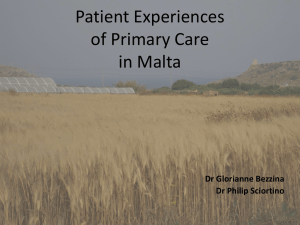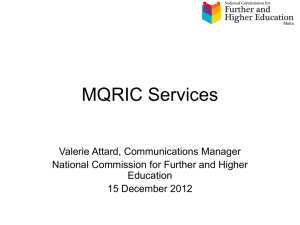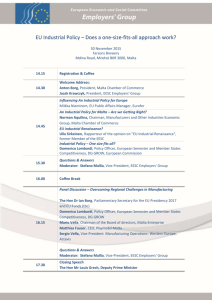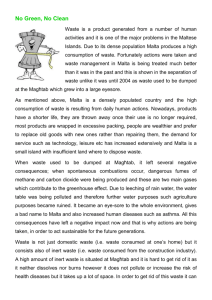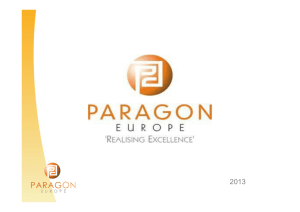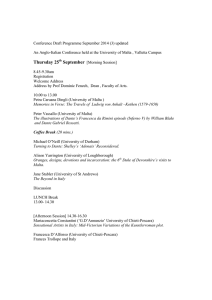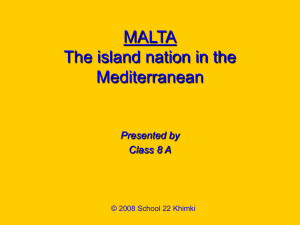x - Blata l-Bajda Secondary School
advertisement
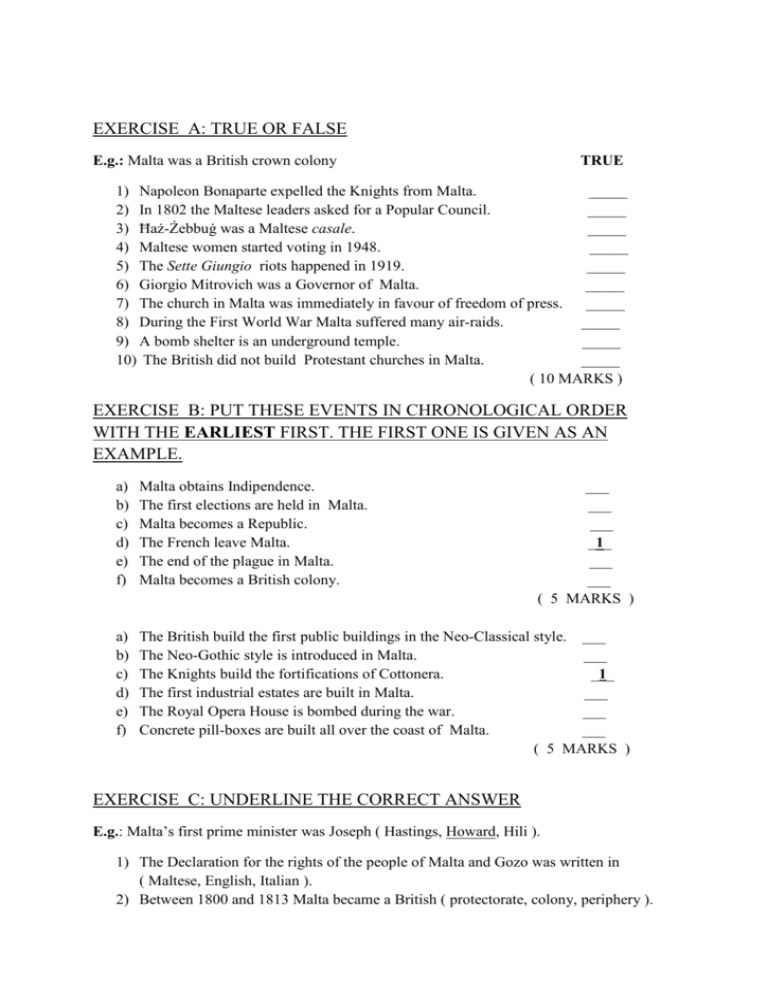
EXERCISE A: TRUE OR FALSE E.g.: Malta was a British crown colony TRUE 1) Napoleon Bonaparte expelled the Knights from Malta. _____ 2) In 1802 the Maltese leaders asked for a Popular Council. _____ 3) Ħaż-Żebbuġ was a Maltese casale. _____ 4) Maltese women started voting in 1948. _____ 5) The Sette Giungio riots happened in 1919. _____ 6) Giorgio Mitrovich was a Governor of Malta. _____ 7) The church in Malta was immediately in favour of freedom of press. _____ 8) During the First World War Malta suffered many air-raids. _____ 9) A bomb shelter is an underground temple. _____ 10) The British did not build Protestant churches in Malta. _____ ( 10 MARKS ) EXERCISE B: PUT THESE EVENTS IN CHRONOLOGICAL ORDER WITH THE EARLIEST FIRST. THE FIRST ONE IS GIVEN AS AN EXAMPLE. a) b) c) d) e) f) Malta obtains Indipendence. The first elections are held in Malta. Malta becomes a Republic. The French leave Malta. The end of the plague in Malta. Malta becomes a British colony. ___ ___ ___ _1_ ___ ___ ( 5 MARKS ) a) b) c) d) e) f) The British build the first public buildings in the Neo-Classical style. ___ The Neo-Gothic style is introduced in Malta. ___ The Knights build the fortifications of Cottonera. _1_ The first industrial estates are built in Malta. ___ The Royal Opera House is bombed during the war. ___ Concrete pill-boxes are built all over the coast of Malta. ___ ( 5 MARKS ) EXERCISE C: UNDERLINE THE CORRECT ANSWER E.g.: Malta’s first prime minister was Joseph ( Hastings, Howard, Hili ). 1) The Declaration for the rights of the people of Malta and Gozo was written in ( Maltese, English, Italian ). 2) Between 1800 and 1813 Malta became a British ( protectorate, colony, periphery ). 3) In the early years of the British control, Malta became a centre for ( culture, contraband, chaos ) . 4) Malta’s first Governor was Thomas ( Strickland, Keenan, Maitland ). 5) A satirical newspaper is about ( sports, humour, religion ). 6) Whoever is found guilty of defamation in a newspaper is guilty of (level, limit, libel). 7) During the Second World War Malta suffered many ( air-raids, invasions, alarms ) by German and ( French, American, Italian ) aeroplanes. 8) The Neo-Classical style has coloumns like the ( Egyptians, Greeks, Phoenicians ). 9) The Addolorata cemetery was designed by Luigi ( Gafa, Galizia, Cassar ) with a ( Baroque, Neo-classical, Neo-Gothic ) style. 10) The first self-goverment was granted in the constitution of ( 1835, 1921, 1964 ). 11) Forti Rinella is in the village of ( Kalkara, Valletta, Marsa ) and has a ( 10, 100, 150 ) Tonne cannon . A similiar cannon used to be found in Fort ( Campbell, Cambridge, Pembroke ). ( 15 MARKS ) EXERCISE D: FILL IN THE BLANKS WITH THE CORRECT ANSWER. THE FIRST LETTER OF THE WORD IS THERE TO HELP YOU E.g.: The Royal Commission of1836 was headed by John Austin u George Cornwall. 1) The Maltese doctor Filippo S___________ was President of the N________Assembly in 1919. 2) In 1802 by the Treaty of A_______ Malta was to return to the Knights of Saint J________. 3) The Reform Party was in favour of E_______ while the Anti-Reform Party was in favour of I_______. 4) During the language question Gerald Strickland was for Free C______ and against the P_____ Passu. 5) The constitution of self-goverment prohibited the Maltese parlaiment from intervening on Reserved M________ which were a prerogative of the Imperial B_______ goverment. ( 10 MARKS ) EXERCISE E: READ PROPERLY THESE TWO SOURCES THEN ANSWER ALL THE QUESTIONS. REMEMBER THAT THE SOURCES ARE THERE ONLY TO HELP YOU AND YOU WILL NOT FIND ALL THE ANSWERS IN THEM. Source A: “ In a large bay in the south of Malta there is a seventeenth century fort. Around it the British built a concrete wall and added cannons running on rails protected with steel windows. Today this fort no longer serves a military purpose , but is used soley for economic reasons. “ SOURCE A Source B: “ In the North of Malta the British built a long line of fortifications , which divide Malta from one part to another. Included in this long line of fortifications there are 4 forts and a cannon battery. Between them there is a long defensive wall with loop holes. In 1892 these long lines of fortifications were named after a famous British queen.” SOURCE B 1) Source A is Fort ( Rinella, San Luċjan, Verdala ) and is found at ( Kalkara, Marsaxlokk, Cospicua ). ( 2 MARKS ) 2) Source B is refering to the ( Elizabeth, Victoria, Anne ) lines built on the Great ( Fault, Caves, Hills ). ( 2 MARKS ) 3) Which rulers of Malta originally built the Fort in Source A ? ______________. ( 1 MARK ) 4) In which century were the fortifications of Source B built ?____________. ( 1 MARK ) 5) What is the reason that the British cannons moved on rails instead of on wheels like the cannons used by the Knights ? _______________________________________ _____________________________________________________________________ _____________________________________________________________________ ( 2 MARKS ) 6) Mention two of the four forts mentioned in Source B. Fort ______________ and Fort _______________. ( 2 MARKS ) 7) What is the name given to the walls joinig the 4 forts and the cannon battery in Source B ? ____________________ ( 1 MARK ) 8) What was the use of the loop holes mentioned in Source B? ___________________________________________________________________ ( 1 MARK ) 9) How is the Fort in Source A used today ? _______________________________________ ( 1 MARK ) 10) What can cause damage to Source B today ? ________________________________ _____________________________________________________________________ _____________________________________________________________________ ( 1 MARK ) 11) Which early twenteeth century invention made these two military sources useless and obsolete ? _________________. ( 1 MARK ) ( 15 MARKS ) EXERCISE F: FIRST CHOOSE THE CORRECT PLACE FROM THE LIST GIVEN BELOW. AFTERWARDS WRITE UNDERNEATH EACH PICTURE IF THESE WERE BUILT IN THE NEO-CLASSICAL OR THE NEO-GOTHIC STYLE. THE FIRST ONE IS GIVEN AS AN EXAMPLE. List: Monument to Ball ; Garrison church ; Main Guard ; Mosta church ; Methodist church at Floriana ; Balluta church. Mosta church 1_________________ Style: Neo-classical Style: ______________ 2 _______________________ Style: ____________________ 3______________________ 4__________________ 5________________ Style: ____________________ Style: ________________ Style: _____________ ( 10 MARKS ) EXERCISE G: READ CAREFULLY THESE TWO SOURCES THEN ANSWER ALL THE QUESTIONS. DON’T FORGET THAT THE SOURCES ARE THERE ONLY TO HELP YOU AND YOU WILL NOT FIND ALL THE ANSWERS IN THEM. Source A: The summary of the report of the Royal Commision of 1836 a) b) c) d) e) f) g) h) The people are illiterate. Few schools. Italian is taught in schools through Maltese. Many people are poor and beggars. Many diseases. Many Maltese are unemployed. Many Maltese are farmers. The population of Malta is very high. Source B: Suggestions given by the Royal Commission of 1878 a) English to be taught through Maltese. b) The Maltese language should be cleaned from Italian words and to become more like Arabic. c) English is to be used in the administration instead of Italian. d) Those who do not know the proper use of English will not be promoted. e) Education is to be made compulsary until 12 years of age. 1) What is the meaning of the word illiterate used in Source A? _____________________________________________________________ ( 1 MARK ) 2) Mention one measure adopted by the British to help reduce illiteracy in Malta from 1836 to 1878. ___________________________________________________________________ ___________________________________________________________________ ( 1 MARK ) 3) Mention one reason why the educational progress in ninteenth century Malta was very slow ? ___________________________________________________________________ ___________________________________________________________________ ( 1 MARK ) 4) Which suggestion from Source B was only implemented in 1946 ? ___________________________________________________________________ __________________________________________________________________ ( 1 MARK ) 5) Besides illiteracy Source A mentions many other social problems. According to your opinion , which of these problems was the worse and why ? ___________________________________________________________________ ___________________________________________________________________ __________________________________________________________________ ( 2 MARKS ) 6) Source A informs us that many Maltese were farmers. However, what was the employment of many Maltese workers who lived in the towns ? __________________________________________________________________ ( 1 MARK ) 7) Can you mention one of the Commissioners of Source B ? ____________________ ( 1 MARK ) 8) Source B suggests that the Maltese language should be cleaned of Italian words and made to sound more like Arabic. (a) Do you agree with this proposal ? ______ (b) Why ?____________________________________________________________ (c) Why did the 1878 Royal Commission make such a suggestion ? ___________________________________________________________________ __________________________________________________________________ ( 3 MARKS ) 9) What was the reaction of the Catholic church in Malta to the suggestions made in Source B ? Why ? _________________________________________________ ___________________________________________________________________ ___________________________________________________________________ ( 2 MARKS ) 10) Which social class was to gain the most from the suggestions of Source B ? _______________________________________________________ ( 1 MARK ) 11) After the controversial suggestions made in Source B a long political argument was to begin , which only ended in 1940. What is the name given o this long political controversy ? ___________________________. ( 1 MARK ) ( 15 MARKS ) EXERCISE H: WRITE ON A SEPERATE FULLSCAP ABOUT 150 WORDS ON ONE OF THESE TITLES. DON’T FORGET TO INDICATE WHICH ONE TITLE WAS SELECTED BY YOU. 1) The Constitutional development of Malta from 1800 to1974. 2) The Sette Giungio and the importance of this event in Malta’s history. 3) Write at least three sentences on each of these five historical personalities: (a) Alexander Ball (b) Thomas Maitland (c) Fortunato Mizzi (d) Sigismondo Savona (e) Patrick Keenan ( 15 Marks ) ( TOTAL OF ALL THE PAPER 100 MARKS )
